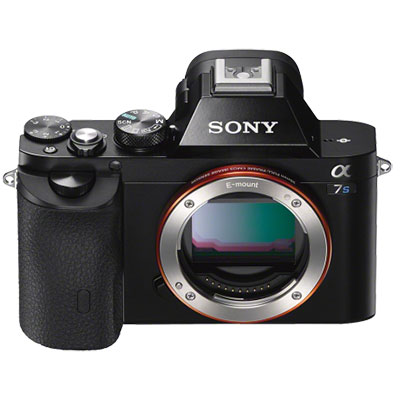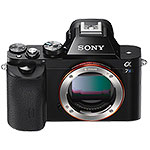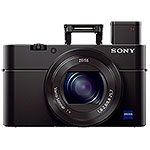Sony A7S

- disruptive tech at its best
- full-sensor video readout
- massive dynamic range
- unprecedented low-light performance
August 15, 2014
Here is what I remember most about film: anticipation. Film added something to every shot, a tilt of color or light, a dash of magic that took the mundane and made it art.
Digital is not like that. We've gained in many ways incomparable advantages by switching to ones and zeros, but in those quantized bits surely anticipation has long since given way to anxiety: fear the scene's dynamic range will exceed what the sensor can handle, fear the shot will look somehow pinched, or lifeless, or artificial.
Photographers work their magic today not with cameras but with Photoshop, using monstrously complex algorithms that all serve, ultimately, to try to put back into the picture what our wondrous digital imaging devices inevitably take out. I confess I'd gotten so used to the process I'd stopped thinking about film entirely. And then I got Sony's new A7S.
The A7S is disruptive technology at its finest. If you've ever heard Kranzberg's Second Law of Technology, this is it, embodied: invention is the mother of necessity.
You may not yet have heard of the A7S, but let me assure you right now you need one. And if instead you are a massive multinational corporation in the business of selling cameras—say, Nikon or Canon—you will soon be scrambling your best engineers in a no-doubt frantic effort to build one. The A7S, to put it as simply as I possibly can, puts the magic back into photography.
Let's talk about what makes the A7S such an odd creature: it costs two and a half thousand dollars, and it has a megapixel count of 12.2. Yes, you read that right: 12 megapixels. Your average smartphone probably doubles that number. What on Earth was Sony thinking when they drew up the A7S? They were thinking Video, frankly. And they were also thinking low-light.
I cannot stress how impressed I am that Sony would put their minds and their money behind such an unlikely creature. Who buys a 12MP camera, marketing must have shrieked. All you all mad? In his first-impressions review of the A7S, Michael Reichmann noted that the A7S's images seem to have a medium-format quality about them.
Such an assertion seems patently absurd until you actually shoot with the A7S and see the results. A7S shots seem almost supernaturally clean and natural, with a filmic quality that, time and time again, delivers not a stilted digital rendering of your scene but rather a remarkably accurate representation of what you actually saw that made you take the picture in the first place.
That is a remarkable (some might say singular) accomplishment for any digital imaging device circa 2014. How, exactly, does this happen? I'm not sure. The A7S has a full-frame sensor, matching the physical size of a 35mm film slide. Dividing that area into only 12 million pixels produces pixels that are much, much bigger than today's ubiquitous tiny sensor-giant pixel count cameras.
Think of those big pixels as big buckets, capturing unusually large amounts of light. This means the A7S can see in the dark. No really—the A7S can see in the dark. And don't dismiss this as a mere parlor trick; the ability to shoot clean images at preposterously high ISOs quickly proves to be a must-have feature (recall: Kranzberg).
When there is abundant light, those big pixels push the noise floor so far down it becomes virtually impossible to find. I suspect—I am speculating here—I suspect we've all grown accustomed to subtle-but-significant amounts of digital noise in our images, and we just don't notice it. Remove it, however, as the A7S does, and suddenly you've got images that evoke...yes, medium format film.
When you can shoot in the dark and get detail, you've got a camera with a massive amount of dynamic range. Funny thing: real life has a lot of range to it. You've probably noticed. You take a picture, some of it is in sunshine, some in shadow. Film could cope with that, but digital sensors: not so much.
How many times have I shot Owens Valley from Whitney portal, wanting to capture that awesome juxtaposition of pine forest and desert, knowing in advance that my camera is going to completely choke on it? The A7S thrives in those situations. The A7S dares you to find a scene it can't handle. Try shooting indoors, with a sunlit window in the scene.
Protect the highlights, and then push up the shadows. And push them up. And keep pushing. It's like nothing you've ever seen before.
There is video to talk about: after all, video production is what the A7S was built for. Philip Bloom says the A7S's HD picture is perhaps the loveliest he's seen on any camera, at any price—including those that cost tens of thousands of dollars. Andrew Reid says the A7S is the best consumer camera Sony has ever made.
The A7S will export (but not internally record) 4K video. This counts as one of the camera's genuine liabilities, particularly next to the obvious competitor here, Panasonic's GH4. The other liability for video—perhaps the only liability—is pronounced rolling shutter that (somewhat) limits the A7S's utility where fast motion (camera or subject) is concerned.
Be aware that to get full-sensor readout video with the A7S in full-frame mode, you have to shoot 24P or 30P. Likely due to heat dissipation issues, a switch to 60P in full-frame gives us the more typical line-skipping moire/aliasing video of a Nikon or Canon DSLR. You can shoot clean 60P in APS-C crop mode if you need it (where you'll also see much less rolling shutter distortion).
The A7S has a very compact form factor for a full-frame camera, but this remains a much larger unit overall than Sony's Alpha-NEX bodies, for example, with their APS-C sensors. Certainly, this is a much lighter, smaller body than a D800, and I have begun hiking with it, favoring it even over my much loved RX100-III. You just want this camera in your hands, always, when you're taking pictures.
Do we really want to jump ship from Nikon or Canon and move to Sony, with its presently-incomplete lens lineup? Well...yes. In terms of video, the A7S is years beyond Nikon or Canon. Can we make giant prints with it? 12MP is a limitation, to be sure. I will watch with interest to see how A7S prints hold up under interpolation. My guess is the A7S is functionally equivalent to a 24MP sensor when it comes to real data—but that's just a guess.
Is it perfect? No, obviously not. Perfect doesn't exist. But Sony's A7S is surely among the most exciting cameras ever made available to photographers at such an accessible price. The A7S, in the end, transcends its technology, reminding us of the magic of film—reminding us why we take pictures in the first place. It makes me feel like an artist again.
 Sony A7S
Sony A7S Sony RX100 M3
Sony RX100 M3